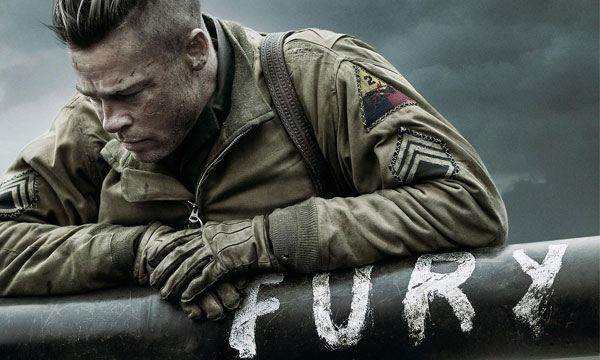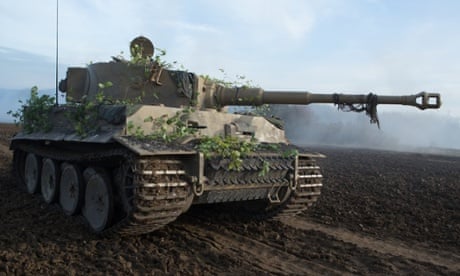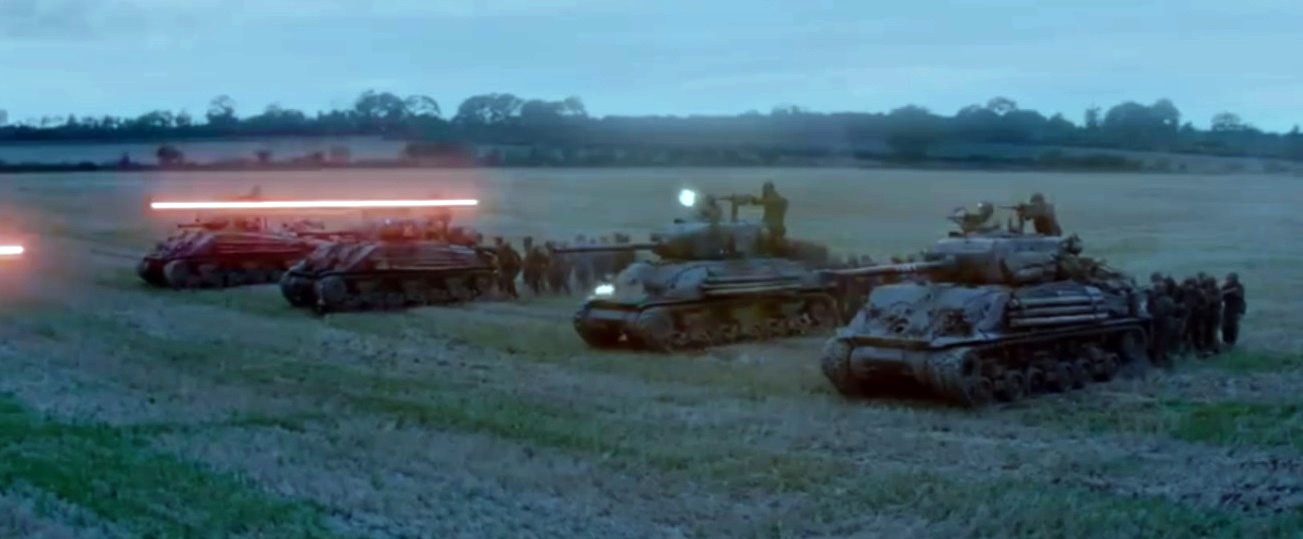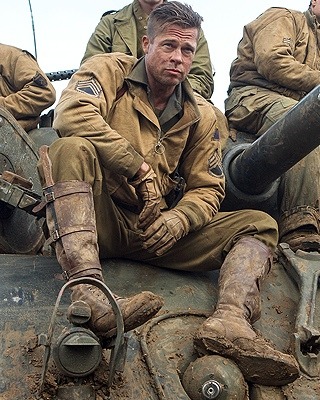I saw “Fury” with my son Luc, and Mark T. and his son Cameron last night. Stopped for a curry at at our favourite restaurant on the way in, and settled in to watch the latest war movie offering at the local cinema.

I thought it was well worth the effort. A brutal, realistic, violent portrayal of tank warfare, a story not often told. I thought it one of the better movies I've seen focusing on the subject.
“Fury” revolves around the tank crew of a late war M4A3E8 Sherman tank with the name “Fury” crudely painted on the barrel of its 76 mm gun. The crew is commanded by Staff Sergeant Don “Wardaddy” Collier (Brad Pitt). The rest of the crew consists of veterans Boyd “Bible” Swan (Shia LaBeouf) the gunner, Grady “Coon-Ass” Travis (Jon Bernthal) the loader, Trini “Gordo” Garcia (Michael Pena) the driver and the very green and sensitive Norman "Eventually to become Machine" Ellison (Logan Lerman), a soldier from the typing pool press-ganged into serving as the bow gunner due to a shortage of trained tank crewmen.
From a historical equipment and military hardware depiction perspective, the movie is great. Unlike most other war movies I've seen there are relatively few inaccuracies to distract from the movie’s message.
I appreciated the use of different types of rounds against different targets as well as personal idiosyncrasies of the lead character carrying a colt six-shooter revolver (A-la Patton, albeit not a pair of pearl handled six-shooters) and a German MP 44 SMG, and also the hypocrisy of looting war medals off dead enemies, displaying them in the tank; and then shooting a German soldier who was wearing a US trench coat in the back. There was several sub-plots that I found quite interesting: History buffs may have picked up on some of them. I may also have missed a few. Later more on that.
The interactions between soldiers, superiors, subordinates, civilians and the enemy come across well, although a bit stereotyped. (Inexperienced and disrespected junior officer sending the platoon off to their doom, and the battle-hardened field commander, "You're all that we have", sorry to send you-in-but-hold-the-line-and-buy-us-time cliches)
Speaking of stereotypes, the director/screenwriter (thankfully) chose not to have the stereotyped African American, Jewish or Italian crew members. No slur intended in saying this, but in some ways I found it refreshing to escape the common Hollywood angst subjects. Instead they opted for a Hispanic, bible punching Episcopalian and a Cajun Swamprat...
German officers were the usual (ho-hum) stereotypes of fanatical Nazis who mindlessly send their troops in to die and kill innocents left right and centre. Even the field officers. Historically this was not the case. Just like the British and Americans, German officers and NCOs led from the front, cared about their men, and even late in the war, and suffered an incredibly high rate of attrition.
The final scene of droves of SS troopers in a suicidal rush attacking a tank with small arms while their officer stands by egging them on, is a little hard to believe. When they were seen marching up they had enough shouldered panzerfausts to make them look like an asparagus field! The officer than later cracks open a packing case, nowhere seen before, and exclaims: "These are the only ones we have"
These were supposedly elite soldiers, well led and trained, and even if inexperienced, their NCOs/officers would not have committed them to a suicide attack while they had perfectly good anti-tank weapons. Against an immobilised Sherman. And not taking cover ? Deploying the MG 42 in the open ?
But I suppose you could pick holes in anything, and the object of the movie is entertainment, and not military accuracy after all.
The German speakers among us also probably picked up that the subtitles were quite often inaccurate to what was being said or written on the placards of the executed civilians, for example. Not that it detracted majorly from the story line, but just saying. (One placard on a strung up woman read: "I would not let my children go to war" and it was subtitled " I would not go to war" and Brad Pitt also read out it incorrectly to his crew. So much for being a German speaker as the movie implies. (Think a little pathos in the script was lost there as a result.)

He also addresses the 20-something young woman as "Maedchen (little girl) where any German speaker would have addressed her as " Fraulein" (Young Lady); as the subtitles this time grammatically correctly read, but did not reflect what he actually said.
The unsung heroes of the movie are the tanks though. The movie features the only running Pzkfw VI Tiger tank in the world (The Bovington Tiger) and uses several versions of the Sherman which would have been very accurate for the time. In Saving Private Ryan a T-34 was dressed up to vaguely resemble either a Tiger or late model PzKfw IV.
Unlike in today’s combat units, Allied units did often have mismatched equipment as new vehicles were supplied to replace older models that were destroyed/damaged beyond repair in combat. Older models were retained until they were considered obsolete or unserviceable. This is noticeable when looking at the American tank platoon that had various models of the M4 Sherman (at least 3 that I could identify without losing the plot of the story by focusing solely on the hardware)

This is historically important, as only the last production model Shermans (Armed with the 76 mm high velocity gun) had any real chance of penetrating most German heavy and medium tanks (Pzkfw V Panther and Tiger I and II by the end of the war) at a distance. German tanks could engage and destroy Shermans at long range, whilst the standard 75mm rounds failed to penetrate the thick frontal armour of the German tanks. It wasn't uncommon to need a five to one (or more) ratio of Shermans to one Tiger to overwhelm the enemy.

The Bovington Tiger
This is accurately portrayed as the 75 mm guns fail to make any impact on the Tiger and its 88 mm take them out with comparative ease over the same distance. The 76 mm of the Easy 8 also only destroys the tiger at short range, from the rear, and by out-maneuvering it, and then firing 2 shots at point blank range
Click here for a walk-around the Sherman M4A3E8 (Easy Eight) that was used in the filming of Fury
One criticism I would have of the fire-fight scenes is the decision to use laser to depict tracer. The flight paths were inaccurate and it looked a little like star-wars. (But then that was probably a safety decision, but it could just as easily have been done in CGI.)

If you've ever seen real tracer fire you'll agree it looks nothing like that. The flight path is more parabolic and appeared linear in the shots. Though the US did use blue tracer, it was far more common to use a yellowish red.The only picture I could find (above) shows the red tracer, but the blue was very apparent in the movie.

I enjoyed a the good Hollywood style yarn, never the less.
The Guardian in the UK has the comments from a 91 year old radio operator veteran on the movie:
"Fury accurately portrays how superior the German tanks were. A Sherman provided you with protection against most enemy fire but against a Tiger it could easily become your coffin. I remember a very near miss where an eight cm shell from a Tiger tank went within inches of our turret and we decided not to stay around too long after that. In open combat we never had a chance. So, like in Fury, we always had to be one step ahead. It was only because we could call up air strikes and had many more tanks than the Germans that we eventually won."
As the film makes clear, a Sherman tank was a lightweight in comparison to a Tiger. The Sherman weighed 33 tonnes and had a 75 mm gun, compared to the Tiger's 54 tonnes and a 88 mm gun. A Tiger also had 3.9 inch thick armour, so shells from a Sherman literally bounced off it.
"Fury shows just how vulnerable you were fighting in a Sherman tank. There is a lot of blood and gore in the film but nothing can really come close to the true horrors of tank warfare. I saw people being blown up and burnt alive. Going to see Fury you don't get that dreadful, nauseating smell of burnt flesh. That will stay with me forever."
"I was in the Essex Yeomanry, a territorial regiment. All the crew were from Essex except me. It took us a while to get along but then I trusted them implicitly with my life. We fought along side the Americans in their Sherman tanks and I found them to be very brave. We didn't write the name of our tank on the barrel like they did in Fury or plaster the inside with photographs but we were just as proud of our tank. Ours was called Beverley and her name was written on the turret."
The corpses certainly mount up in Fury, particularly in the final scene. This was the only part Bill, (the veteran) too, felt lacked credibility.
"I thought the film showed accurately how tough life could be in a tank, but the final scene where the crew hold out against a battalion of Waffen SS troops was too far fetched. The Germans seemed to be used as canon fodder. In reality they would have been battle-hardened and fanatical troops who would have easily taken out an immobile Sherman tank using Panzerfausts (an anti-tank bazooka).
They also seemed to have an inexhaustible supply of ammunition and fuel. A Sherman tank only does five miles to the gallon so I think they would have run out long before the final showdown."

The Easy 8 used in the film as well as the Tiger are now on display at Bovington. Clink on the link for more pictures of both vehicles and the opening of the display: Blackmore Vale Magazine